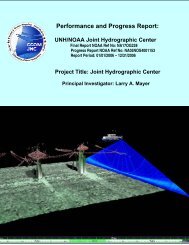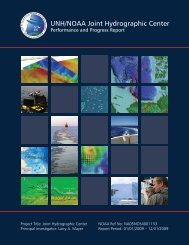Vessel Tracking Using the Automatic Identification System (AIS ...
Vessel Tracking Using the Automatic Identification System (AIS ...
Vessel Tracking Using the Automatic Identification System (AIS ...
You also want an ePaper? Increase the reach of your titles
YUMPU automatically turns print PDFs into web optimized ePapers that Google loves.
Schwehr 2011: Presented at US Hydro, Tampa Fl 2<br />
to identify risks, quantify <strong>the</strong>m, and be ready rapidly<br />
deal with <strong>the</strong> results of an incident.<br />
We must us use each incident as an opportunity to<br />
learn and improve our response tactics. While <strong>the</strong> long<br />
time period of <strong>the</strong> active oil spill/wild well of <strong>the</strong> Deepwater<br />
Horizon incident was horrible, it gave responders<br />
an unprecedented chance to move forward on developing<br />
and testing systems that are only rarely put through<br />
<strong>the</strong>ir full paces. Drills are important, but <strong>the</strong>y are frequently<br />
not of <strong>the</strong> same intensity of an actual response.<br />
The costs to peoples’ lives, <strong>the</strong> environment, and our<br />
economy must at least pay us back with knowledge<br />
gained for future responses. BP’s estimates <strong>the</strong>ir cost<br />
from <strong>the</strong> oil spill at $16B (BP, 2011) - an amount that<br />
does not represent <strong>the</strong> total cost to all involved.<br />
The background presented here highlights <strong>the</strong> need<br />
for increased funding, research and training for our hard<br />
working response teams.<br />
What is <strong>AIS</strong>?<br />
The marine <strong>Automatic</strong> <strong>Identification</strong> <strong>System</strong> (<strong>AIS</strong>)<br />
is a ship-to-ship and ship-to-shore messaging system<br />
sent without human intervention over marine VHF radio.<br />
The primary goal for <strong>AIS</strong> during <strong>the</strong> initial design<br />
during <strong>the</strong> 1990’s was to assist with safety of navigation,<br />
and specifically, to improve situational awareness<br />
of mariners for collision avoidance. <strong>AIS</strong> is specified<br />
by an International Telecommunications Union Recommendation<br />
(ITU, 2010), IEC Standards, and documents<br />
by IMO, IALA, and a number of o<strong>the</strong>r organizations.<br />
While <strong>the</strong> IEC documents are not freely available, Raymond<br />
(2010a), as a part of <strong>the</strong> GPSD project, created<br />
<strong>the</strong> “AIVDM/AIVDO protocol decoding” document -<br />
written as an open summary of <strong>AIS</strong> without <strong>the</strong> author<br />
looking at <strong>the</strong> closed standards.<br />
The transmission of <strong>AIS</strong> messages occurs on two<br />
VHF channels, VHF-FM channel 87B (161.975 MHz)<br />
and 88B (162.025 MHz), giving <strong>the</strong> system roughly lineof-sight<br />
capability (ranges typically 30-80km for shipto-ship).<br />
The messaging architecture is built around<br />
256-bit (32 byte) packets called ”slots”. Each channel<br />
is organized into 1 minute long ”frames” composed of<br />
2250 slots.<br />
<strong>AIS</strong> transceivers work toge<strong>the</strong>r in a self-organized<br />
time division multiple access (SOTDMA) scheme to<br />
pick which slots to use (Lans, 1996). Small areas effectively<br />
build up <strong>the</strong>ir own cells. Antennas at higher<br />
altitudes, such as on planes, are able to cover wider<br />
areas, but often receive messages from multiple cells<br />
and messages from neighboring cells may collide with<br />
each o<strong>the</strong>r. While satellites are proven platforms for<br />
receiving <strong>AIS</strong> messages, transmitting from spacecraft is<br />
certain to reach many different cells, each with its own<br />
organization of slots, causing interference with many<br />
ship messages.<br />
An individual <strong>AIS</strong> message is allowed to be 1 to 5<br />
slots long, but messages using 4 and 5 slots are discourage<br />
because of VHF noise issues that greatly reduce <strong>the</strong><br />
probability of correctly receiving longer messages. The<br />
first slot of message contains 88 header bits, meaning<br />
that <strong>the</strong> first slot only contains 168 bits (21 bytes) of<br />
usable data. The result is that <strong>AIS</strong> messages are only<br />
21 to 85 bytes in size. This is smaller than <strong>the</strong> space<br />
available in Twitter messages or short message service<br />
(SMS) mobile phone text messages. Within a cell, <strong>the</strong><br />
overall 2-channel throughput has a <strong>the</strong>oretical capacity<br />
of 19.2 kbps that is reduced to 11.2-12.6 kbps by <strong>the</strong><br />
slot overhead. There have been discussions as to what<br />
VHF Data Link (VDL) loads are reasonable for SOT-<br />
DMA (Germany and Sweden, 2007). Assuming that a<br />
50% load is sustainable without degrading <strong>the</strong> safety of<br />
life aspects of <strong>AIS</strong>, <strong>the</strong> maximum total throughput is<br />
only 5.6-6.3 kbps of message data.<br />
There are two classes of transceivers for ships. (Note:<br />
These are technically not transponders). Class A systems<br />
transmit with 12.5 W power and at a higher priority<br />
than Class B systems, which are limited to 2 W<br />
power. Class B systems also transmit position reports<br />
less often. A Minimum Keyboard Display (MKD) is<br />
mandated for Class A hardware and ship operators may<br />
choose to integrate <strong>the</strong> <strong>AIS</strong> information into <strong>the</strong>ir Electronic<br />
Charting <strong>System</strong> (ECS). Class B units typically<br />
have no built in display and must have an ECS to be<br />
able to view <strong>AIS</strong> information. Many small vessels carry<br />
receive only <strong>AIS</strong> units, trading safety for a very small<br />
monetary savings compared to purchasing a Class B<br />
transceiver. Arroyo (2009) summarizes <strong>the</strong> carriage requirements<br />
for <strong>AIS</strong> devices in <strong>the</strong> United States.<br />
There are a number additional types of equipment<br />
that complement <strong>the</strong> <strong>AIS</strong> transceivers on vessels. First,<br />
<strong>the</strong>re are specially designed high end receive only units<br />
meant for monitoring <strong>AIS</strong> from towers, aircraft, unmanned<br />
aerial vehicles (UAVs), autonomous surface vehicles<br />
(ASVs), and satellites (S-<strong>AIS</strong>). These use specially<br />
designed antennas, electronics, and filtering systems<br />
to receive <strong>the</strong> largest number of <strong>AIS</strong> messages possible.<br />
Decoding data in a slot with a collision is sometimes<br />
possible with fancier processing algorithms. Additionally,<br />
some <strong>AIS</strong> receivers can direction find <strong>AIS</strong><br />
transmissions <strong>the</strong>reby assisting locating vessels that<br />
have <strong>AIS</strong> units with non-functioning GNSS position sys-




